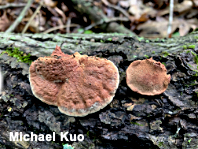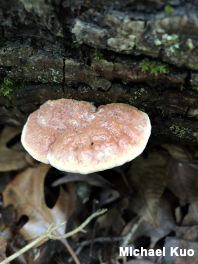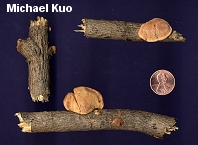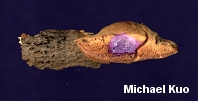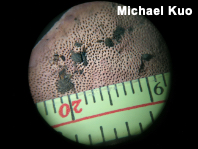| Major Groups > Polypores > Hapalopilus nidulans |

|
Hapalopilus nidulans [ Basidiomycota > Polyporales > Phanerochaetaceae > Hapalopilus . . . ] by Michael Kuo This nondescript, fleshy, dull orangish polypore is often overlooked; it tends to blend in with its surroundings. A drop of KOH anywhere on the fruitbody, however, produces a rather stunning color change to purple or lilac (see the illustration). Truth be told, KOH is probably not required for successful identification—but it's fun! Like viewing the horned cystidia of Pluteus cervinus or watching the sea-green color change of Boletus separans in ammonia, it's one of those things a true mushroom geek never tires of. Absent the KOH reaction, Hapalopilus nidulans is recognized by its dull orange colors, its fairly fleshy consistency, the absence of a stem, and the small, angular pores. In eastern North America it is found on hardwood logs and debris, but in the southwest it favors conifer wood. My collections (all from Illinois) have somewhat smaller spores than what is usually reported for the species. Polyporus nidulans is a former name; Hapalopilus rutilans is a synonym. Description: Ecology: Saprobic; growing alone or in small groups on decaying logs and sticks; on hardwood debris in the east, or conifer wood in the southwest; causing a white rot; spring to fall, or over winter in warmer climates; widely distributed east of the Rocky Mountains, and occasionally reported in the southwest and Pacific Northwest. The illustrated and described collections are from Illinois. Cap: 2.5–7 cm across; 1–3 cm deep; irregularly semicircular or kidney-shaped; convex; bald or finely suedelike; wrinkled in places; evenly dull orange to dull orangish cinnamon; when fresh and growing with a paler, yellowish to whitish margin. Pore Surface: Dull orangish brown; not bruising, or bruising slightly darker; with a sterile marginal band; with 2–3 angular pores per mm; tubes 2–4 mm deep. Stem: Absent. Flesh: Dull orangish brown or paler; watery and soft at first, but later quite tough and hard; not changing when sliced. Odor and Taste: Not distinctive. Chemical Reactions: KOH bright purple to lilac on all parts. Spore Print: White. Microscopic Features: Spores 2.5–3.5 x 1.5–2.5 µm; ellipsoid; smooth; inamyloid; hyaline in KOH. Basidia 4-sterigmate. Setae, cystidia not found. Hyphal system monomitic, with conspicuous clamp connections. REFERENCES: (Fries, 1821) Karsten, 1881. (Overholts, 1953; Smith, Smith & Weber, 1981; Gilbertson & Ryvarden, 1986; Phillips, 1991/2005; Lincoff, 1992; Barron, 1999; Roody, 2003; McNeil, 2006; Binion et al., 2008; Kuo & Methven, 2014.) Herb. Kuo 07160304, 07060701, 06260902, 06221802. This site contains no information about the edibility or toxicity of mushrooms. |
© MushroomExpert.Com |
|
Cite this page as: Kuo, M. (2018, December). Hapalopilus nidulans. Retrieved from the MushroomExpert.Com Web site: http://www.mushroomexpert.com/hapalopilus_nidulans.html |
